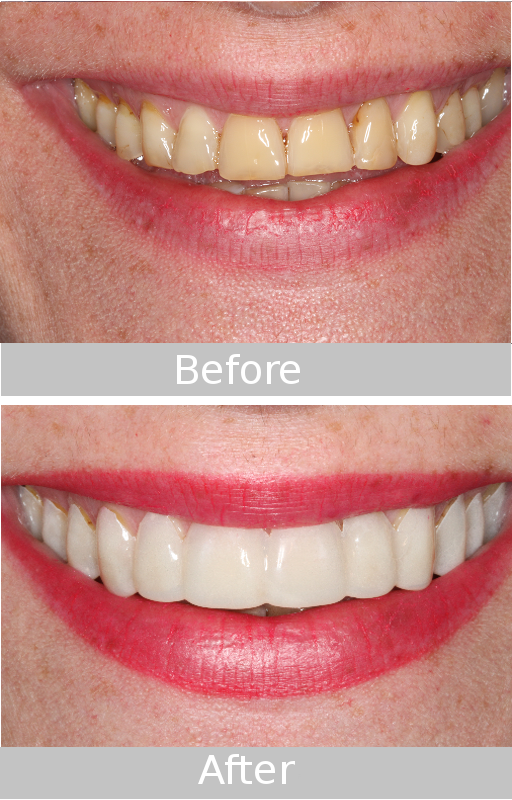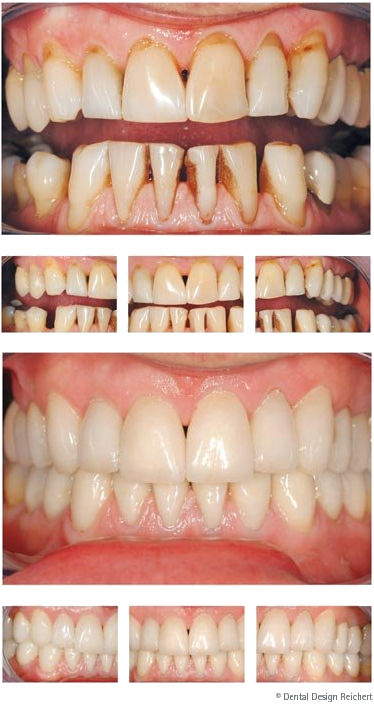Mock-Up
Mock-Up - get to know your new smile
Test your new veneer and take your time to decide.
What is a Mock-UP?
A Mock-UP is an elastic dental splint manufactured so you can view your future veneers in your mouth and test them out.

The major advantage of this is that you can see the new situation directly in your mouth so you can take your time at home to decide whether you like it or whether you want to change something about it.
This can all be achieved without having to have an operation on your teeth.
The creation of a Mock-UP also offers further advantages.
On the one hand, you can use it to test how functional the veneers are, and on the other hand the tooth colour can be selected in advance when using a Mock-UP. This means you can see your “new” smile in advance and get to know it.
A Mock-UP is particularly suitable for patients who are not satisfied with the colour, shape or position of their teeth but who cannot imagine how it will look after treatment.
Manufacture
Imprints of your teeth are taken for a tooth model.
Our dental technician will then model the desired situation that you want to achieve through the treatment on the plaster model created from the imprint. This is also called creating a wax-up. You can use the model to see what the final result could look like.
The next step is then manufacturing the Mock-UP, the elastic splint that is taken from the wax-up model that has been made.
This means you can take your time to consider the aesthetic change and the dentist can check all of the functional conditions and carry out a phonetic check focusing on the F, S and Sh sounds.
Costs
The manufacture of a Mock-Up, including the previous steps such as the taking of impressions, photos, planning and manufacture of a wax-up model costs EUR 200.00.
Angstpatienten
Never again fear going to the dentist
Almost everyone has a certain degree of fear about dental treatment. In some cases, however, this can be classified as a phobia of dentists.
This feeling of panic-stricken anxiety means that patients avoid visiting the dentist, which results over time in the condition of the teeth becoming poor.
If you fall into this group of patients, we can provide some relief with the help of our anaesthetist, Dr Bieger-Stehnkuhl. The latest intravenous anaesthesia procedures enable anxiety and pain-free treatment.
No impairments of your general well-being or problems such as nausea are to be expected after anaesthesia either.
Just take the first step and have a consultation. Your first visit can also be outside of the treatment room or not in the treatment chair, in a relaxed atmosphere.
Perfekte Veneers
No-prep veneers - a minimal operation with maximum effect
The veneer technique presented here does not require any grinding of the teeth or an anaesthetic injection.
Everybody wants to be beautiful, and beautiful teeth are simply part of a winning appearance.
But many people shy away from letting the dentist beautify them. Crowns and bridges which neither look like natural teeth nor are manufactured by experienced technicians continue to be sold and used.
Dr Tschackert is as yet the only dentist in Europe to combine beauty and function with the latest and most modern LVI method from America. In this way, you can improve your smile significantly with just one to three visits to Dr Tschackert & Colleagues. Take a look at this completely pain-free dental aesthetic procedure and let yourself be inspired by the modern yet simple treatment concept.
It's as easy as that:
First session
Discussion
First of all the patient's wishes are discussed in detail and then a diagnosis model and a photo analysis are prepared after the clinical examinations. We measure the models for you free of charge and use these to determine the number of no-prep veneers using the photos and the model. We will carefully analyse which type of no-prep veneer you need, as the shape and colour of the veneers are always planned individually for each patient.
Second session
Impressions are taken without anaesthetic/injections and with no preparation of the teeth
Before the veneer treatment starts, any remaining questions are discussed with the patient and if necessary our master dental technician. The difference between these and conventional veneers is that the no-prep veneers do not require any preparation (or in rare cases require very slight preparation). This veneer treatment is pain-free and no anaesthetic injection is needed. A precise impression of the jaw is then taken for the no-prep veneers and and impression of the opposing jaw is also taken.
Third session
Fitting and final insertion/adhesion
Since there is no option to insert the no-prep veneers temporarily and to wear them to try them out, attention must be paid to the final appearance during the fitting of the no-prep veneers. Only when the desired effect of the no-prep veneers has been achieved are the no-prep veneers attached to the teeth using an adhesive technique. These veneer treatment steps are also pain-free and no anaesthetic injection is needed.
CMD
Back pain, headaches, tinnitus, migraines - many problems often have a common and mostly undiscovered cause: the teeth!
Find out more here about our successful treatment concept to release yourself from these problems.
What is CMD?
The smallest changes in the teeth, jaw, muscles and temporomandibular joints can cause a range of disorders of the temporomandibular joint and functional disorders. In dentistry, these disorders are known as craniomandibular dysfunction (CMD). CMD is nothing new in dentistry. Dental function diagnostics and function therapy is an area in which we have additionally specialised.
How is craniomandibular dysfunction expressed?
Craniomandibular dysfunctions occur in people of all ages and can be identified through various different symptoms.
The following should be noted in particular: pain when chewing, speaking, swallowing or yawning, limited opening of the mouth and pain in the head and jaw. A malocclusion can even cause back pain, migraines and tension in the neck and muscles.
But unclear jaw positioning, background pain or sporadic pain, irregular or regular noises in the temporomandibular joint, which can also be possible on both sides, and painful muscle tension in the region of the cheeks or temples, above average wear of the teeth (abrasions), exposed, hypersensitive tooth necks, isolated loosening of the teeth or tooth migration and chewing on one side can also cause these problems.
What are the causes of CMD?
The different clinical pictures mean that various different causes of CMD can also be considered: grinding the teeth, whiplash, tension, back pain caused by poor posture, incorrect positioning of the temporomandibular joint or incorrect positioning of the teeth or cracking of the temporomandibular joint.
CMD in children? In children in particular, the symptoms of craniomandibular dysfunction mentioned should be prevented and their development identified as early as possible and positively impacted so no CMD can develop. A first but often neglected symptoms is disorders of symmetry.
In children in particular, the symptoms of craniomandibular dysfunction mentioned should be prevented and their development identified as early as possible and positively impacted so no CMD can develop. A first but often neglected symptoms is disorders of symmetry.
Only when they are felt to be unsightly and aesthetically harmful are they treated. Many disorders of symmetry such as sucking-related open bite, caused by having a dummy or sucking the thumb for too long or a lack of milk teeth have a cause in early childhood.
If a disorder of this type such as a slightly crooked head posture, one shoulder being higher than the other or pelvic misalignment is not taken seriously and treated, a functionally unstable situation in the entire musculoskeletal system develops. If this is not corrected, the situation will result in a number of changes which continue into adulthood.
In children in particular, the earlier the treatment is started, the faster we see success.
How can craniomandibular dysfunction be treated?
CMD is curable and can be treated using mouthguards in the lower and if necessary upper jaw and additional physiotherapy. Medications can be administered if necessary. Also if necessary, permanent mouthguards or a long-term temporary solution on the side teeth to stabilise the bite or alternative orthodontic treatment can be used.
Interdisciplinary expertise is required to cure CMD, which is which treatment must be carried out by a craniosacral specialist such as Dr Tschackert.
What is involved in CMD treatment?
With our successful treatment concept, your problems can be alleviated in just three treatment sessions.
1. CMD treatment session/consultation
At the start, the patients problems are discussed in detail, and if necessary clinical examinations will be carried out afterwards. Following clarification of the costs, diagnosis models will also be created. Following a telephone consultation about treatment goals, you will then receive your documents with a complete overview in the form of a personal treatment plan.
2. CMD treatment session
We will use a special device (such as K7 by Myotronics, Seattle) suitable for you to measure your jaw and determine treatment on the basis of this.
3. CMD treatment session
Final insertion, for example of a permanent or removable mouthguard.


 +49 (0)69 28 30 30
+49 (0)69 28 30 30  praxis@tschackert.com
praxis@tschackert.com